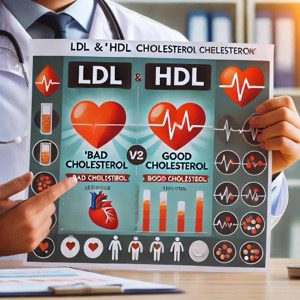Why Cholesterol Tests Are More Than Just Numbers
Imagine your bloodstream as a busy highway. LDL (“bad”) cholesterol is like heavy traffic, clogging the roads and causing blockages, while HDL (“good”) cholesterol acts like a cleanup crew, keeping the path clear. But how do you know if your balance is right?
That’s where LDL and HDL Tests come in. These simple cholesterol blood tests help determine your risk of heart disease, stroke, and other cardiovascular issues. If you’ve never had one, it’s time to understand why they matter.
What Are LDL & HDL Tests?
A lipid panel test measures different types of fats in your blood, but the LDL and HDL tests specifically focus on the two most critical:
1. LDL (Low-Density Lipoprotein) – “Bad” Cholesterol
✅ Why it’s bad: High LDL leads to plaque buildup in arteries, increasing the risk of heart attack and stroke.
✅ Healthy levels: Below 100 mg/dL (or below 70 mg/dL for high-risk individuals).
✅ How to lower LDL: Reduce saturated fats, exercise, and consider medication if needed.
2. HDL (High-Density Lipoprotein) – “Good” Cholesterol
✅ Why it’s good: HDL removes excess cholesterol, reducing the risk of clogged arteries.
✅ Healthy levels: Above 40 mg/dL for men and 50 mg/dL for women (higher is better).
✅ How to increase HDL: Eat healthy fats, quit smoking, and stay active.
Why These Tests Matter
Many people assume cholesterol problems only affect older adults, but high LDL and low HDL can impact anyone at any age.
🔴 High LDL means higher heart attack risk.
🟢 Higher HDL means better heart protection.
⚠️ Even if your total cholesterol is normal, an unhealthy LDL-HDL balance can still be dangerous.
These tests help detect problems early—before they lead to serious complications..
Fasting vs. Non-Fasting LDL and HDL Tests
Traditionally, doctors recommended fasting for 9-12 hours before cholesterol tests. However, non-fasting cholesterol tests are now considered accurate in most cases.
🔹 Fasting Test: Preferred if you have high triglycerides or a history of heart disease.
🔹 Non-Fasting Test: More convenient, but may show higher triglyceride levels.
How to Check Your LDL & HDL Levels
You have several options to get tested:
✅ Visit a Doctor or Lab: Search for “cholesterol test near me” to find clinics offering lipid panel tests.
✅ At-Home Cholesterol Test Kits: Convenient for regular monitoring. Look for FDA-approved cholesterol home test kits.
✅ Free Cholesterol Test Programs: Some pharmacies and health centers offer free cholesterol tests.
What If Your LDL Is High or HDL Is Low?
🔴 High LDL levels?
➡️ Reduce fried foods, processed meats, and sugary snacks.
➡️ Add more fiber, omega-3s, and heart-healthy fats.
➡️ Consider medications like statins if prescribed by your doctor.
🟢 Low HDL levels?
➡️ Increase physical activity (even brisk walking helps!).
➡️ Eat more nuts, fish, and olive oil.
➡️ Quit smoking—it lowers HDL significantly.
Take Control of Your Heart Health Today
Your LDL & HDL balance determines how well your body handles cholesterol. If you haven’t had a test recently, now is the time. Small changes today can prevent major heart problems tomorrow!
Next Steps:
✅ Schedule a cholesterol blood test or check at home.
✅ Monitor your LDL & HDL levels regularly.
✅ Make heart-healthy lifestyle changes for better results.
Sources & Acknowledgments
This article is based on data from reputable sources, including:
- ClinicalTrials.gov – Providing the latest clinical trial information.
- OpenFDA – Offering reliable drug and medical device data.
We ensure all information is accurate, up-to-date, and aligned with expert-reviewed medical sources. Always consult a healthcare professional for medical advice.
Sources & Acknowledgments
This article is based on data from reputable sources, including:
- ClinicalTrials.gov – Providing the latest clinical trial information.
- OpenFDA – Offering reliable drug and medical device data.
We ensure all information is accurate, up-to-date, and aligned with expert-reviewed medical sources. Always consult a healthcare professional for medical advice.
